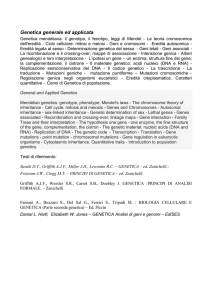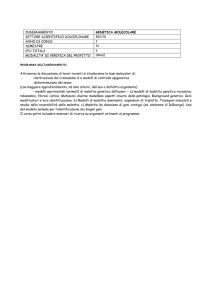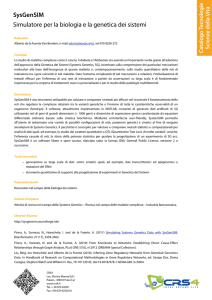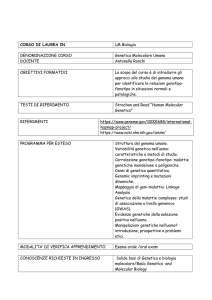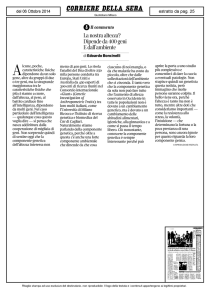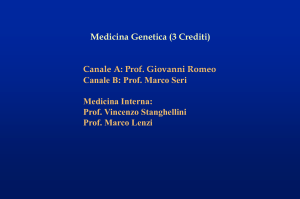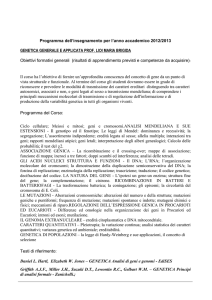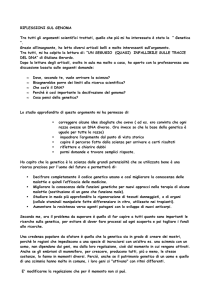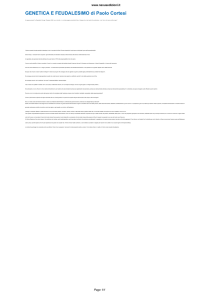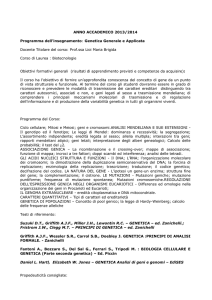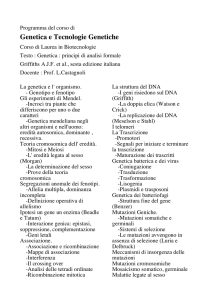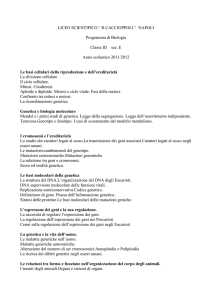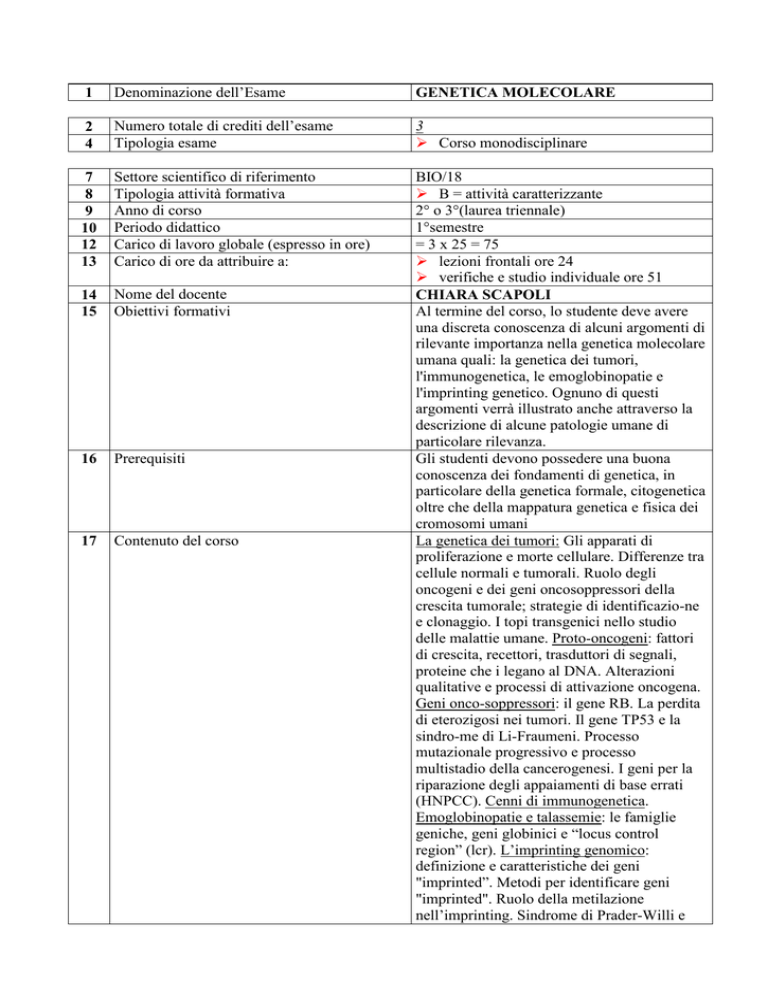
1
Denominazione dell’Esame
GENETICA MOLECOLARE
2
4
Numero totale di crediti dell’esame
Tipologia esame
3
Corso monodisciplinare
7
8
9
10
12
13
Settore scientifico di riferimento
Tipologia attività formativa
Anno di corso
Periodo didattico
Carico di lavoro globale (espresso in ore)
Carico di ore da attribuire a:
14
15
Nome del docente
Obiettivi formativi
16
Prerequisiti
17
Contenuto del corso
BIO/18
B = attività caratterizzante
2° o 3°(laurea triennale)
1°semestre
= 3 x 25 = 75
lezioni frontali ore 24
verifiche e studio individuale ore 51
CHIARA SCAPOLI
Al termine del corso, lo studente deve avere
una discreta conoscenza di alcuni argomenti di
rilevante importanza nella genetica molecolare
umana quali: la genetica dei tumori,
l'immunogenetica, le emoglobinopatie e
l'imprinting genetico. Ognuno di questi
argomenti verrà illustrato anche attraverso la
descrizione di alcune patologie umane di
particolare rilevanza.
Gli studenti devono possedere una buona
conoscenza dei fondamenti di genetica, in
particolare della genetica formale, citogenetica
oltre che della mappatura genetica e fisica dei
cromosomi umani
La genetica dei tumori: Gli apparati di
proliferazione e morte cellulare. Differenze tra
cellule normali e tumorali. Ruolo degli
oncogeni e dei geni oncosoppressori della
crescita tumorale; strategie di identificazio-ne
e clonaggio. I topi transgenici nello studio
delle malattie umane. Proto-oncogeni: fattori
di crescita, recettori, trasduttori di segnali,
proteine che i legano al DNA. Alterazioni
qualitative e processi di attivazione oncogena.
Geni onco-soppressori: il gene RB. La perdita
di eterozigosi nei tumori. Il gene TP53 e la
sindro-me di Li-Fraumeni. Processo
mutazionale progressivo e processo
multistadio della cancerogenesi. I geni per la
riparazione degli appaiamenti di base errati
(HNPCC). Cenni di immunogenetica.
Emoglobinopatie e talassemie: le famiglie
geniche, geni globinici e “locus control
region” (lcr). L’imprinting genomico:
definizione e caratteristiche dei geni
"imprinted”. Metodi per identificare geni
"imprinted". Ruolo della metilazione
nell’imprinting. Sindrome di Prader-Willi e
sindrome di Angelman.
Griffith AJF, Gelbart WM, Miller JH,
Lewontin RC - GENETICA MODERNA I e
II, ed. Zanichelli, 2000.
Benjamin L., GENES VII (in alterantiva
GENES V o VI). Oxford University Press,
2000.
Strachan T. and Read A.P. HUMAN
MOLECULAR GENETICS 2 (II edizione),
ed. BIOS, 1999.
Watson JD, Gilman M, Witkowski J, Zoller M
- IL DNA RICOMBINANTE, ed. Zanichelli,
1994.
18
Testi di riferimento:
19
Modalità didattica
convenzionale
20
Modalità esame
Scritto
orale
1
Course Title:
MOLECULAR GENETICS
2
4
Total examination credits
Typology of examination
3
monodisciplinary course
7
8
9
10
12
13
Scientific field of reference
Typology of reference educational activity
Year of degree course
Semester
Global workload (in hours)
Time distribution
14
15
Teacher’s name
Educational Goals
16
Prerequisites
17
Course syllabus
BIO/18
B = characterizing activity
2nd or 3rd (Second level degree)
1st semester
= 3 x 25 = 75
24 hours for lectures
51 hours for progress tests and
individual work
CHIARA SCAPOLI
The course has been designed to
introduce fundamental concepts and
technological advances in the study of
human molecular genetics, such as
cancer genetics, the genetic basis of
immunity, hemoglobinopathies and
genomic imprinting. Each of these topics
will be outlined through the description
of some of the most relevant human
diseases.
Students should have a good knowledge
of basic concepts of genetics, with
particular care of Mendel's laws, their
extensions and complicating factors,
cytogenetics and of the construction of
genetic linkage maps of mendelian traits.
Cancer genetics: the cell cycle, growth
regulation and apoptosis. Proprieties
distinguish a cancer cell from a normal
cell. Oncogenes, tumour suppressor
genes and cancer growth: strategies in
identifying and cloning cancer genes.
Transgenic mice as animal models of
human diseases. Proto-oncogenes:
growth factors, receptors, signal
transduction proteins, DNA binding
factors. Qualitative mutations and
oncogenic activating processes. Tumour
suppressor genes: the RB gene; loss of
heterozygosity in cancers. The TP53
gene and Li-Fraumeni syndrome.
Stepwise mutational changes and
clinical progression of carcinogenesis.
Mismatch repair genes and HNPCC. The
genetic basis of immunity.
Hemoglobinopathies and thalassemia:
18
Reference books
19
20
Teaching activities
Exams
gene families, globin genes and locus
control region” (lcr). Genomic
imprinting: definition and characteristics
of imprinted genes. Methods in
identifying imprinted genes. DNA
methylation and imprinting. Prader-Willi
and Angelman syndromes.
Benjamin L., GENES VII. Oxford
University Press, 2000.
Strachan T. and Read A.P. HUMAN
MOLECULAR GENETICS 2 (II
edizione), ed. BIOS, 1999.
HUMAN MOLECULAR GENETICS.
Strachan T. and Read A.P. (II edition
1999) - BIOS ed.
Recombinant DNA. Watson, Gilman,
Witkowski, and Zoller. 2nd Ed.
Scientific American Books, distributed
by W.H. Freeman, New York,
1992.
BASIC HUMAN GENETICS. Mange
E.J. and Mange A.P. (II edition 1999)
Sinauer ass. ed.
conventional
written
oral

